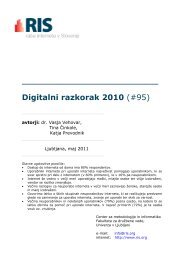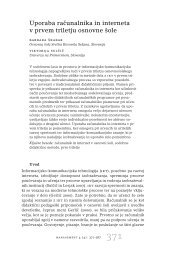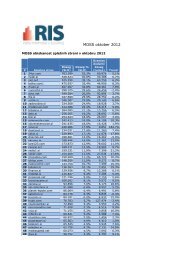the Labour Market Survey Report - Council of European ...
the Labour Market Survey Report - Council of European ...
the Labour Market Survey Report - Council of European ...
Create successful ePaper yourself
Turn your PDF publications into a flip-book with our unique Google optimized e-Paper software.
5. Estimating Skill Shortages<br />
Even where industrial structure is only changing slowly, employers <strong>of</strong> IT Practitioners rarely find it easy<br />
to articulate <strong>the</strong>ir current and (particularly) future skill needs very precisely. These needs can in principle<br />
be fulfilled from within <strong>the</strong>ir own staff (<strong>the</strong> shortfall <strong>of</strong> skills within employers’ existing staff is termed<br />
– in <strong>the</strong> UK - “skills gaps”), or by recruiting new people (buying in people from <strong>the</strong> available supply in<br />
<strong>the</strong> external labour market – generally problems in finding <strong>the</strong> “right” people in this way are referred to<br />
as skill shortages).<br />
Fur<strong>the</strong>rmore, employers may not be able – or may choose not – to afford <strong>the</strong> necessary action to reduce<br />
<strong>the</strong>ir problems in this area. Trying to measure such shortages <strong>of</strong> supply in a labour market has a number<br />
<strong>of</strong> difficulties, and trying to predict how such shortages will develop in <strong>the</strong> future is increasingly hard,<br />
particularly in a time <strong>of</strong> continuing change <strong>of</strong> work practices. There are thus fundamental limitations in<br />
both identifying skill shortages in existing labour markets and in forecasting <strong>the</strong>ir development in <strong>the</strong><br />
future. These need to be considered separately.<br />
5.1 Possible Approaches<br />
a) Estimating skill shortages in relation to labour stock levels (numbers in employment) is not easy.<br />
Generally, researchers view estimates <strong>of</strong> grossed up samples <strong>of</strong> Employers’ reported “Hard-t<strong>of</strong>ill<br />
vacancies” as <strong>the</strong> least unsatisfactory indicator <strong>of</strong> recruitment difficulties – i.e. shortages <strong>of</strong><br />
supply in <strong>the</strong> market-place. However, labour markets contain a number <strong>of</strong> additional complexities<br />
beyond <strong>the</strong> operation <strong>of</strong> product or service markets, including <strong>the</strong> problem <strong>of</strong> “churn”*.<br />
b) Estimating skill shortages from <strong>the</strong> growth <strong>of</strong> economic/business activity that produces a<br />
growing demand for labour is a risky business. In essence, very few forecasts can be shown to<br />
have been fulfilled, and indeed general macro economic modelling is <strong>of</strong>ten now not to be used<br />
directly in forecasting (Smith, 1998).<br />
A helpful review from <strong>the</strong> <strong>European</strong> Science and Technology Observatory <strong>of</strong> <strong>the</strong> different aspects <strong>of</strong><br />
forecasting in relation to high technology skills more broadly is given in Ekeland and Tomlinson (2001):<br />
<strong>the</strong> study examines <strong>the</strong> relevant labour markets in terms <strong>of</strong> stock/flow indicators for both relevant<br />
sectors (NACE) and occupation (ISCO).<br />
The prevailing approach is generally to estimate skills demand levels from a productivity factor applied<br />
to business activity levels arising from assumed economic growth in a sector.<br />
5.2 Existing Estimates for <strong>the</strong> <strong>European</strong> Union<br />
The two significant sets <strong>of</strong> estimated levels and forecasts for IT practitioners within Europe recently<br />
carried out are those by IDC (in particular through <strong>the</strong> 2001 <strong>European</strong> IT Observatory – EITO - <strong>Report</strong>)<br />
and an analysis carried out for <strong>the</strong> Career-Space industry consortium (drawing in particular on work<br />
carried out within IBM United Kingdom).<br />
* where – at a time <strong>of</strong> very high shortage – employees frequently leave <strong>the</strong>ir current employer to earn more at ano<strong>the</strong>r.<br />
72<br />
| C E P I S I.T. PRACTITIONER SKILLS IN EUROPE | Section 5

















